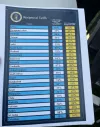Sunday History: Liberty Ships, when the U.S. Built Ships In Under 5 Days.
Discover how Liberty ships powered WWII logistics and how Malcolm McLean's container shipping revolutionized global trade. A journey through maritime history.

Liberty Ships and the Birth of Container Shipping. Talk about production by 1943, it was possible to build one in just under 4 to 5 days.
by John Costine, March 5, 2025
Liberty Ships
Liberty ships were a type of cargo ship built during World War II to support the massive logistical needs of the Allies. These ships played a crucial role in enabling the Allies to move troops, supplies, and war materials across the oceans, which was vital for the success of the war effort.
How They Changed World War II
Liberty ships revolutionized wartime shipping. They were designed to be built quickly and in large numbers, making them the backbone of the U.S. Merchant Marine during WWII. They allowed for the rapid transport of military supplies, food, and ammunition across the Atlantic and other theaters of war. Their importance cannot be overstated—without them, the Allies might have struggled to sustain their campaigns, especially in Europe, where the Nazis had cut off vital supply lines.
These ships ensured the Allies could maintain the flow of war material, even as German U-boats attacked shipping routes. The Liberty ships' large numbers helped mitigate the losses at sea, as they could be produced faster than they could be sunk.
Production Speed
One of the most impressive aspects of Liberty ships was how quickly they could be built. The design was intentionally simple, using standardized parts that allowed for mass production. The first Liberty ship, SS Patrick Henry, was launched in 1941 and took around 244 days to build, but by 1943, it was possible to build one in just under 4 to 5 days. The most efficient yards were able to launch a ship every 2 to 3 days by the war’s end. This was a staggering feat and marked a key achievement in industrial production during the war.
Number Built
A total of 2,710 Liberty ships were built during World War II. The United States constructed them in a vast number of shipyards across the country, with some of the largest production centers located on the West Coast, like in Portland, Oregon, and on the East Coast, such as in New Jersey and Philadelphia. The construction of these ships was a monumental effort that involved thousands of workers, including many women who took on the job during the war as part of the “Rosie the Riveter” movement.
Locations of Construction
Liberty ships were built in 18 different shipyards across the United States. Some of the most famous yards include:
- Kaiser Shipyards in Portland, Oregon, and Richmond, California, were among the most efficient in producing these ships.
- Bethlehem Steel's Fore River Shipyard in Quincy, Massachusetts, was another major production site.
- Brunswick Shipyards in Brunswick, Georgia, played a key role as well, producing a significant number of Liberty ships during the war.
- Other notable locations included shipyards in California, Texas, and Louisiana.
Brunswick Shipyards, like other shipyards across the country, played a crucial part in the massive industrial effort to construct the thousands of Liberty ships needed to support the war effort. The yard’s involvement in shipbuilding was part of the larger effort to supply the Allies with the transport vessels necessary for victory.
The Brunswick Shipyards, after the war, continued to have a legacy of shipbuilding and maintenance. While the primary focus of the yard during WWII was the production of Liberty ships, it also worked on other types of ships and contributed to the overall success of the U.S. Navy's wartime logistics.
Brunswick Shipyards was an important location in the U.S. shipbuilding effort during WWII, and adding it to the list of Liberty ship production sites helps complete the picture of the vast effort behind the creation of these essential vessels.
Are Any Still Around?
Yes, a few Liberty ships have survived into the present day, though very few are still in operational condition. Some of them have been preserved as museum ships or historical landmarks.
- SS John W. Brown (Baltimore, Maryland): This ship is one of the two remaining Liberty ships that are still afloat and open for tours. It is a museum ship that operates occasionally for educational purposes.
- SS Jeremiah O'Brien (San Francisco, California): Another Liberty ship that remains preserved as a museum ship. It is still occasionally used for special events and educational purposes, and it’s the only one that operates regularly as a museum.
These surviving ships serve as important pieces of history, reminding us of the vast industrial effort required to win the war, and the vital role these ships played in the success of the Allies.
Liberty ships were a game-changer in WWII, providing the logistical support necessary for the Allies to sustain their war effort. They were built quickly and in massive numbers, and while most were scrapped after the war, a few are still preserved today as historical landmarks.
Malcolm McLean and the Birth of Container Shipping
After World War II, global trade increased significantly, but the way cargo was handled was still incredibly inefficient. Goods were typically loaded and unloaded from ships manually, often one box at a time. This system was slow, costly, and prone to damage. However, the real transformation of global shipping came with Malcolm McLean, an American businessman who recognized the potential for a more efficient system.
McLean’s vision led to the creation of container shipping, which would change how goods were moved across the world forever.
T-2 Tankers as a Starting Point
Before container ships, McLean was involved in the shipping industry through his ownership of a trucking company, McLean Trucking Company. He saw the inefficiencies in the shipping of goods and thought about how shipping could be streamlined. In 1955, McLean bought a fleet of T-2 tankers, which were surplus ships from the U.S. Navy after World War II. The T-2 tankers were large oil tankers used primarily during the war, and McLean realized that they could be converted for a more efficient method of cargo transport.
These T-2 tankers would become the basis for McLean's idea to create the first container vessels. They were ideal for modification because they had the necessary hull size to accommodate standardized shipping containers, but their design was largely focused on oil transport, so major adjustments were needed.
The First Container Ships
In 1956, McLean launched a revolutionary concept: using steel containers that could be loaded onto ships, trucks, and trains seamlessly. This method would eliminate the inefficiencies of manual cargo handling. The key idea was that containers could be filled with goods and then simply moved from one form of transport to another without unloading the contents. This drastically sped up the loading and unloading process, reduced labor costs, and minimized damage to goods.
McLean’s company, Sea-Land Service, was the first to use containerized shipping on a large scale. The first voyage of a container ship took place on April 26, 1956, with a ship called the Ideal-X, which was a converted T-2 tanker. The Ideal-X made its journey from Newark, New Jersey, to Houston, Texas, carrying 58 standard containers. This marked the birth of containerized shipping, which would go on to revolutionize global trade.
How This Changed Shipping
The efficiency gains from containerized shipping were astounding. Instead of manually loading and unloading cargo piece by piece, entire containers could be transferred in a matter of minutes. It lowered transportation costs and allowed goods to be transported more quickly, and eventually more cheaply. This innovation laid the foundation for modern global trade.
Are T-2 Tankers Still Around?
The T-2 tankers themselves were largely decommissioned after World War II and replaced by more modern vessels. Most were scrapped or repurposed for other uses. However, the conversion of those T-2 tankers into early container ships represents a critical moment in the development of the container shipping industry, one that’s still foundational to modern logistics.
Conclusion
Malcolm McLean’s adaptation of T-2 tankers for containerization was a pivotal moment in the history of global shipping. His use of standard shipping containers drastically improved efficiency and helped lay the groundwork for the modern interconnected global economy.
Connect with Mr. John Costine:






